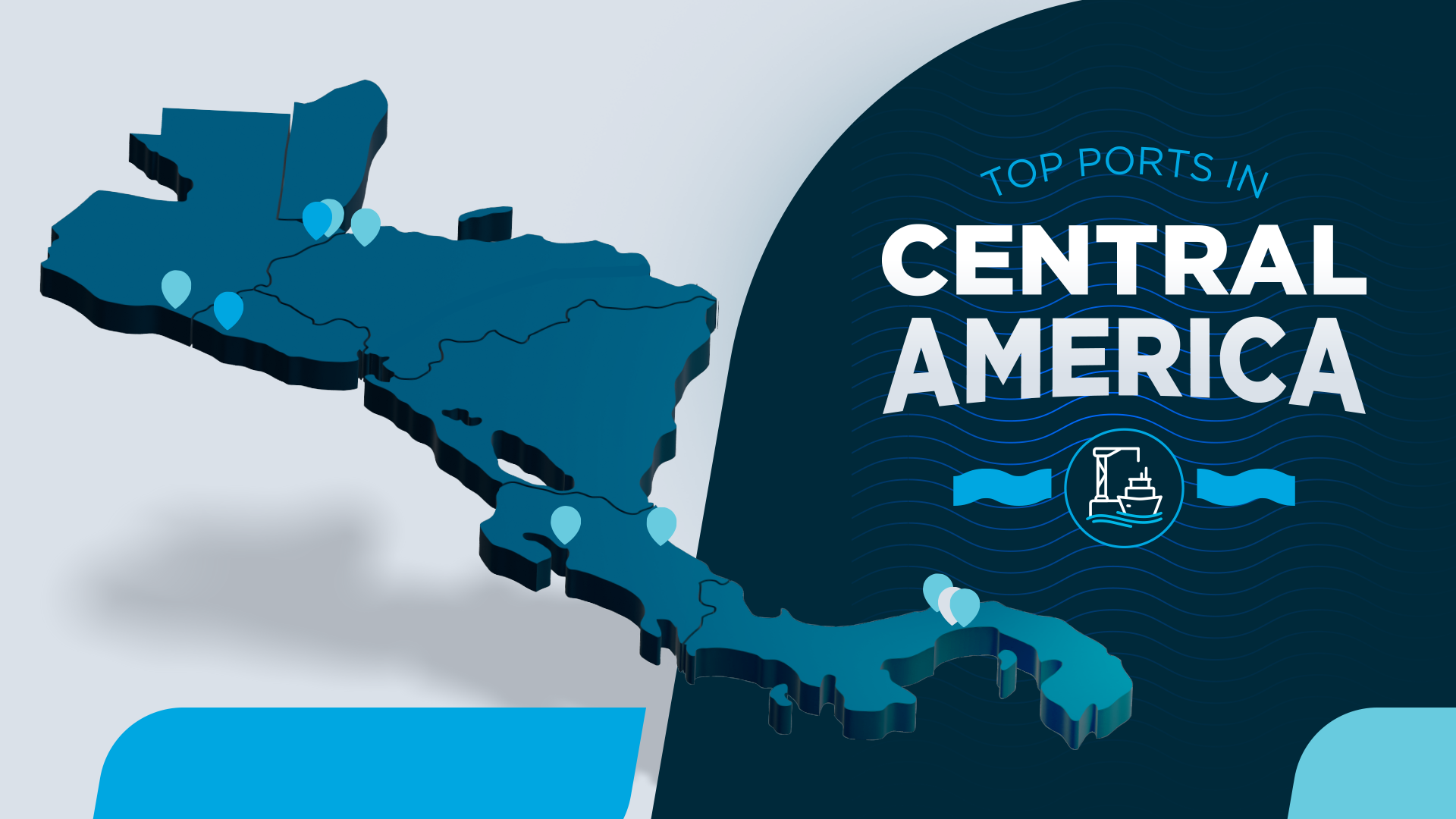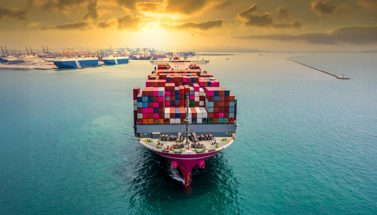
Today’s Top 10 Ports in Central America
Understanding Central America’s top 10 ports is crucial to your supply chain strategy for one simple reason: the Panama Canal. While proximity to the canal significantly benefits supply chain strategies, it's only one of the advantages these ports provide.
Today, Central American ports provide outstanding opportunities for facilitating efficient and economical transshipment, trade with Central American countries, and nearshoring logistics.
Navigating these opportunities, and the challenges that come with global shipping, is a specialty of Trailer Bridge’s freight forwarding agents, who work with Central American ports daily. Here’s our take on the top 10 ports in the region.
1 - Port of Colón in Panama
The top three Central American ports are located in Panama. The first is the Port of Colón, a complex of three ports on the Atlantic side near the north entrance of the Panama Canal. This complex includes the Colón Container Terminal (CCT), Manzanillo International Terminal (MIT), and the Port of Cristóbal. Together, they handled around 4.8 million TEUs (twenty-foot equivalent units) in 2023, making Colón the 41st busiest port in the world. (Lloyd’s List)
MIT is integrated with the Colón Free Trade Zone and serves some of the world’s largest steamship lines, including Maersk and MSC. In 2024, MIT processed 2.7 million TEUs. It has berth depths and gantry cranes to accommodate post-Panamax vessels, along with more than 2,800 reefer plugs to sustain temperature-controlled cargo. (Portal Logistico de Panama)
Colón Container Terminal (CCT) is the newest of the three ports that make up the Port of Colón complex. In 2024, it processed 1.57 million TEUs, with transshipments accounting for 87.1% of its volume. Equipped with 16.4-meter deep-water berths and super post-Panamax gantry cranes, CCT is built for the biggest vessels and designed for future expansion.(Portal Logistico de Panama)
The Port of Cristóbal is a major transshipment hub with berth depths of 15 meters to accommodate the largest vessels, along with strong rail and road connectivity. Handling about 1.1 million TEUs in 2024, Cristóbal is well-equipped for containers, roll-on-roll-off (RORO) operations and cruise lines. (TRADLINX)
2 - Port of Balboa in Panama
The second-largest port in Central America, the Port of Balboa, is located on the Pacific side of the Panama Canal. In 2024, it handled 2.63 million TEUs, with 88.3% of those containers classified as transshipments, making Balboa a key distribution hub for trade between Asia and the Americas. (Portal Logistico de Panama)
First opened in 1909, the Port of Balboa has 5 container berths and approximately 100 acres of container storage. Along with deep-water berths and super post-Panamax cranes, the port also offers convenient rail access, allowing containers to be transshipped across Panama to Colón as an alternative to maritime transport.
Balboa’s primary volume comes from containers, including reefers, with 3,612 reefer connections available.(Portal Logistico de Panama) The port’s infrastructure is also built to handle RoRo shipments, dry and liquid bulk, and specialized cargo.
Hutchinson Ports operates the Port of Balboa. Since 1997, the company which operates port terminals around the world, has made considerable investments in the Port of Balboa’s berths and operations.
3 - PSA Panama International Terminal
PSA Panama saw its throughput rise to 1.38 million TEUs in 2024. Located at the Pacific entrance of the Panama Canal, this port opened in 2010 as a newer alternative to the Port of Balboa, which has been operating for over 100 years.(Portal Logistico de Panama)
PSA Panama’s modern features include berths that can accommodate a maximum draft of 16.3 meters and post-Panamax cranes that can work the largest containerships. Investments in modern gate infrastructure, Optical Character Recognition technology (OCR), and the installation of 2,000 reefer connections point to a port designed for future growth. (PSA Panama)
The port is strategically located at the intersection of global trade routes connecting major markets in the Americas, Europe, and Asia. PSA Panama is set up to serve as a transshipment hub for Asian cargo, with 93.5% of its 2024 volume consisting of transshipments.(Portal Logistico de Panama)
PSA Panama also has direct access to the Pacific Logistics Corridor, a highway spanning from Pacific to Atlantic across Panama that can provide an efficient alternative to waterborne transport.
4 - Moin/Limon Complex in Costa Rica
Costa Rica’s two-port complex on the Caribbean coast is comprised of the Moin Container Terminal and Puerto Limon. Together they handled over 1.3 million TEUs in 2023, making the ports a leading transshipment hub in the region. (Port Economics)
Operated by APM Terminals, part of A.P. Moller-Maersk, the Moin Container Terminal is built on an artificial reef. Operational since 2019, the Moin Terminal has deep-water berths of 14.5 meters and an access channel 18-meters deep, along with super post-Panamax cranes. (APM Terminals website)
Covering nearly 100 acres, Moin benefits from significant investments by APM, supporting its ongoing development. Recognized as one of the most modern ports in the region, Moin leverages APM’s advanced technology, including state-of-the-art data services and APIs, to enhance both operational efficiency and security.
Puerto Limon traces its roots back to 1852. While Moin is primarily container-focused, Limon handles a mix of containers and RoRo freight. Imports passing through Puerto Limon for local use include iron, cardboard, fertilizers, chemical products, fuels, and petroleum. Major exports from the port include bananas, citrus fruits, vegetables, coffee, and textiles. (Marine Insight). Puerto Limon is also Costa Rica’s largest cruise port.
The Moin/Limon Complex’s proximity to the Panama Canal offers shippers an alternative to congested regional ports, along with modern advantages other ports in the region may lack.
5 - Puerto Cortes in Honduras
The Port of Cortes, or Puerto Cortes as it is most known, is located on the Atlantic coast of Honduras. It processed 753,000 TEUs in 2023. (Port Economics) 90% of the country’s ocean import and export traffic moves through Puerto Cortes. (Logistics Cluster)
A deep-water port with super post-Panamax cranes, Puerto Cortes is capable of handling Panamax ships with maximum capacity of 12,500 TEUS. (ICTSI) It is also recognized as one of the most efficient port’s in the region, offering advanced features like leading-edge cargo tracking, automated gate control, and specialized reefer zones. (The Freight)
The port is strategically located near key regional and global shipping routes in the Caribbean. Puerto Cortes serves as a nearby hub for exports to the U.S. Gulf Coast and East Coast. It was the first port in Central America to be included in the Container Security Initiative, allowing U.S.-bound containers to be inspected by U.S. Customs officials directly in Honduras. (Wikipedia)
Important exports moving through Puerto Cortes include bananas, coconuts, coffee, flour, and hardwood. The port is also the main gateway for imports to Honduras led by shipments of cotton yarn, used vehicles, and construction materials.
The location, combined with comprehensive infrastructure, including a free trade zone, provides shippers with advantages for containerized and bulk cargo operations.
6 – Port of Quetzal in Guatemala
The Port of Quetzal, or Puerto Quetzal, is Guatemala’s leading Pacific port, having logged 581,030 TEUs and 1,186 vessel calls in 2021. (Logistics Cluster)
The port has a strategic location stemming from its access to Asian trade routes as well as the west coast of the Americas. It’s status as one of the largest ports between Mexico’s Pacific ports and the Panama Canal is unique.
Puerto Quetzal is a rare port on the west coast of Central America capable of handling 10,000-TEU vessels with a maximum draft of 14.5 meters. (Logistics Cluster) Features like super post-Panamax cranes, hundreds of reefer plugs, and a multipurpose ramp enables the port to handle a wide range of cargo, including RoRo cargo, solid and liquid bulk cargoes, and containers.
Key imports flowing through the port include fertilizer, wheat, corn, clinker, mineral coal, fuel, liquified natural gas, iron, vehicles, and cement. (Puerto Quetzal)
The top cargoes exported through the Port of Quetzal are sugar, ethyl alcohol, palm oil, bananas, and melons. (Puerto Quetzal)
Continuous modernization is a key focus of the port. Operated by APM Terminals, the port and has received ongoing investment. A state-of-the-art terminal operating system strengthens security, control, and container management at the port. (APM Terminals)
The Port of Quetzal is also the focus of a project launched by the Government of Guatemala with the Global Alliance for Trade Facilitation to simplify, standardize, and digitize documentation and procedures at its major ports. (Logistics Cluster)
7 – Port of Santo Tomas de Castilla in Guatemala
Guatemala’s Port of Santo Tomas de Castilla on the Atlantic handled 553,235 TEUs and recorded 823 vessel calls in 2024. (Puerto Santo Tomas de Castilla)
The Port of Santo Tomas is a critical link for Guatemala’s trade with the U.S., Europe and Caribbean. It is also well situated to support trade between Central America and Asian markets as well as exports that are the product of nearshoring in Guatemala.
With six berths and the nearby Zolic free trade zone, Santo Tomas is Guatemala’s largest commercial port. This port handles 60% of Guatemala’s container volume and 65% of the country’s liquid bulk shipments. (Logistics Cluster)
Cargoes handled by the port include bulk grains, fertilizers, bagged coffee, and palletized bananas. It also has pipelines to facilitate the shipment of tallow and oil products. (SHIPNEXT)
Operations at Santo Tomas are supported by equipment including mobile cranes, reach stackers, and over 900 reefer connection points. (Logistics Cluster)
8 – Port of Barrios in Guatemala
In 2022, the Port of Barrios handled 525,402 TEUs and served 554 vessels. (Puerto Barrios) The Port of Barrios shares the Atlantic side of Guatemala with another top port, The Port of San Tomas de Castilla, but each serves a distinct role in the country’s trade.
With roots stretching back to 1880, the Port of Barrios is well connected to Guatemala’s banana-growing industry. Agricultural exports remain a key focus of the port today.
The port operates one pier with four berths that can accommodate ships with a maximum draft of 9.5 meters. The Port of Barrios commonly receives container ships, general cargo carriers, oil and chemical tankers, and containerships transporting reefers. (Logistics Cluster)
Vessels calling at the port are served by mobile harbor cranes that can lift a maximum load of 124 tons. To handle temperature-controlled cargoes, the Port of Barrios installed 1,100 plug stations. (Logistics Cluster)
The port’s master plan includes quadrupling their number of mobile cranes and increasing the available draft to 15 meters to accommodate the largest container vessels. In concert with other improvements, these moves will increase current capacity by 40% when complete. (Puerto Barrios)
9 - Port of Caldera in Costa Rica
Costa Rica’s Port of Caldera serves as a Pacific Coast counterpoint to the country’s Moin/Limon Port Complex on the Caribbean. The Port of Caldera, which handled 348,271 TEUs in 2024, (Hanseatic Global Terminals) plays a unique and significant role in the Costa Rican economy and global supply chain.
Caldera’s proximity to the Panama Canal and its location near East-West trade routes position it to play a vital role in the global supply chain and the regional economy. Good connectivity via the national rail line and highways support port logistics. Costa Rican highways connect Caldera to the capital city of San Jose in two hours and provide access to locations throughout the country.
The port has two container terminals served by mobile harbor cranes, reach stackers, and conveyor systems. Caldera’s warehousing capabilities include approximately 50 acresof covered storage space available for dry goods, as well as refrigerated and frozen storage areas for perishable commodities. (Puntarenas.com)
The port processes about one-third of Costa Rica’s agricultural exports, including high-value crops like bananas, pineapples and coffee. Caldera is also a key hub for receiving a diverse range of imported cargo that includes consumer goods, agricultural products like soybeans, raw materials like coal, wood and minerals, textiles, electronics, and machinery.
In recent years, the port has experienced historic volumes and unprecedented port congestion. The port’s operator, Sociedad Portuaria de Caldera (SPC) is addressing the over-capacity issues and in 2024 invested $5 million toward improvements to port infrastructure and other root causes. (Container News)
10 – Port of Acajutla in El Salvador
El Salvador’s Port of Acajutla on the Pacific coast is the country’s largest, moving 178,800 TEUs in 2024—a jump of 8.4% from the previous year. (Dinero.com.sv)
The Port of Acajutla specializes primarily in bulk cargo. Acajutla serves as a vital export and import hub for the nation’s economy, and recent events point to the port’s potential to become a key commercial hub in the region.
The announcement in 2024 of a $1.6 billion investment by Yilport Holding Inc. group in El Salvador’s Port of Acajutla and Port of La Unión will bring infrastructure improvements projected to triple capacity at Acajutla. Yilport will jointly operate the port in partnership with El Salvador's Autonomous Port Executive Commission (CEPA). (Reuters)
The Port of Acajutla handles most of El Salvador’s exports of key domestic products, including coffee, sugar, and balsam of Peru. Main imports handled by the port include machinery parts, food items, and petroleum and chemical products. The country’s largest oil refinery is in Acajutla, and oil imported from Venezuela passes through the port’s oil terminal. (Marine Insight)
The U.S. is El Salvador’s main trading partner. Trade with the U.S. drives a large portion of the import and export traffic passing through the Port of Acajutla. Much of the port’s export activity also involves reexporting goods that arrive to El Salvador from countries in Central and South America. (Britannica)
Know Your Port Options in Central America
Port congestion is a growing issue in Central America. Delays from overcapacity at ports can have a host of ramifications ranging from costly demurrage and production interruptions to product spoilage and dissatisfied customers.
Knowing alternative ports in the region that can help keep your cargo moving reliability and efficiently is key. The good news is that shippers today have excellent options in Central America, with ports that have modern infrastructure and technology.
Nevertheless, the reality is that even with a positive outlook shaped by top performers in the region, port logistics will always be dynamic. Shippers need to be prepared for the unexpected.
As an experienced global freight forwarder, seasoned in the resources and relationships of Central American port logistics, Trailer Bridge International can be an invaluable partner. Reach out to a team member to discuss the opportunities and vulnerabilities in your supply chain strategy.
Related Articles






